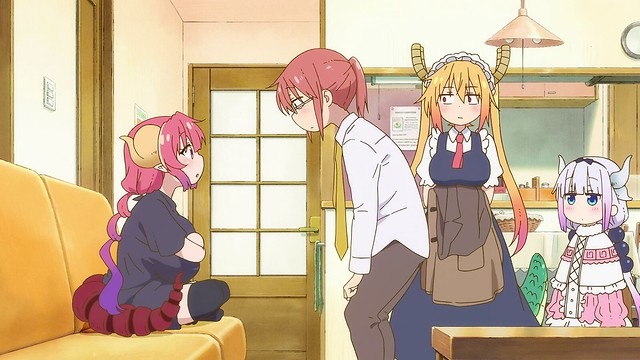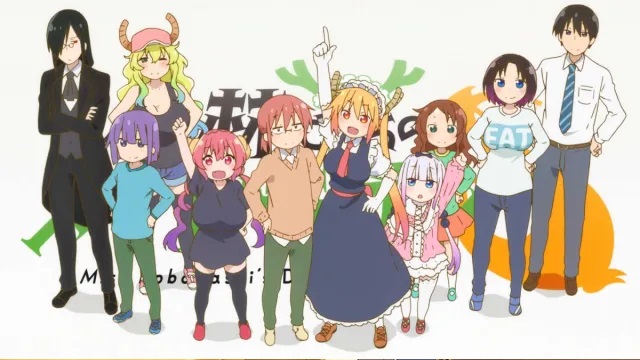








"Miss Kobayashi's Dragon Maid S" is the follow-up second season of the anime. It meant a lot because of the popularity of the first season, but more specifically, because it was Kyoto Animation's first new TV anime after the tragic arson attack in 2019. The original director, Yasuhiro Takemoto, was one of the victims, and it fell to Tatsuya Ishihara to take his place. More than anything, I wanted to support the show, and hope that the positive-messaging of the series would raise spirits, but was also concerned about whether it could recapture the magic of the first season.In the second season, everything is status quo from where the first season left off, except for a brand new dragon: Illulu. She barges in right away, looking to fight the dragon maid Tohru for living peacefully alongside humans. Ilulu is short, with magenta red hair, sharp fangs, and massive knockers... not just as big as her head, but almost bigger than her body... oh dear...Yeah, Ilulu was divisive from the start. The show was already "body-positive" for different types, but this seemed to cater to a completely different audience. Even compared to anime's stereotype of female designs, this was over-the-top. It didn't help that she spent the early episodes barefoot, and her proportions and childish behaviour made her seem like a young child. It's appropriate to the lore - they're actually "flame sacks," and their size represents her fire-power - but even for fans of the first season, it would be understandably for them to completely skip this second season. Bizarrely, Ilulu's vendetta storyline is resolved quite quickly, and by episode 3, things calm back down to a slice-of-life comedy where nothing of significance happens. Which kind of defeats the purpose of bring Ilulu into the fold in the first place. However, Ilulu does have a tragic, if simple, backstory that makes her likable, and it didn't take long to overlook first impressions and enjoy her being in the cast. Adding yet one more dragon helps add some variety in the jokes, settings, and character dynamics (Tohru is frequently jealous when Ilulu receives any sympathy or attention from Kobayashi). The "S" could mean a bunch of things, and the opening song cleverly suggests it could mean "unStoppable," "superb-sensational," "stimulating," "spontaneous," "shine," "supreme," or simply just "second season." It could also mean "sexy." The first season pushed some boundries but was able to remain mostly lighthearted. Here, those boundaries seem to get pushed a little further from all characters. Naturally, from Ilulu, who is both chidlish and mature enough to know that her assets can tease men. But also Tohru, who seems a little more aggressive in showing her "love" for Kobayashi (and the show teases growth in Kobayashi's position towards the "relationship," but chooses not to commit to it). And Kanna and her school friend Riko, whose outbursts occur so frequently and extremely that Riko clearly has an unhealthy love-crush for Kanna, not just an overload to her cuteness. And Lucoa too, which at least isn't surprising. The show is still tame and sweet compared to the average anime (the kind aimed to 14-year-old boys), but crossing that edge feels out of place to what could be a wholesome, all-ages treat. Otherwise, "S" could also mean more of the "same," which is a good thing. As far as slice-of-life anime goes, "Miss Kobayashi" still has more humour and personality than the rest of them. There is a vague sense that even the characters are getting a bit bored - Tohru goes out to find part-time work out of boredom, for example, and some episodes are just about lazing around Kabayashi's apartment. Or having fights in an open field for sport. But they always find something to do. Surprisingly, all the characters seem to get a fair share of attention, even Fafnir, the one male dragon. Some fun scenarios include when Fafnir enlists Lucoa's help in making a manga, and when Kanna runs away and accidently ends up in New York for a day.  One thing that surprised me was how "S" expands the "story" (or lore) for the cast. We get a peak at Tohru and Elma's life centuries earlier, and how they came to end up in Japan. This expanded backstory for most of the cast wasn't something I thought I needed, but it helped give depth to what I otherwise thought were one-joke stereotypes. This still isn't exacting a riveting drama, but compared to most slice-of-life shows (where there's virtually no story at all), this is welcome. The visuals and animation for "S" are mostly on par with the first season, but for some reason, I wasn't as overwhelmed or impressed as I was the first time, perhaps because it wasn't new or fresh. But thanks to an active use of action scenes with their dragon powers, there's opportunity for the animators to stretch themselves and have fun. The music is great, and the opening and ending themes are perfectly suited to listen to alongside those from the first season, even with some subtle callbacks to those original songs. The English dub provided by Funimation (now Crunchyroll) continues the cast from Season 1. Similar to before, it's fine and grew on me, but this is a clear case where the original Japanese dub is better all around. However, this was one of the only cases I could recall where quality control in the script was a problem - in at least two cases (episodes 4 and 10), the Englsih dub changed a line. Not just for creative license, but by missing a key word in the phrase, causing the sentence to mean the opposite and make no sense in the context of the scene. I had to rewind multiple times to ensure I didn't miss it, and checked it against the Bluray's subtitled version, and sure enough, the sub was right, the dub was wrong. I assume this was a victim of Funimation's quick-turnaround "simuldub" schedule, and the sheer volume of shows they had to record. I can imagine the scriptwriter misunderstanding the line, not double-checking with anyone, and not bothering to fix it for the eventual home video release, where a separate subtitle QC handled their job correctly without checking the dub. Other than lore-specific keywords, anime scripts typically aren't complicated and these mistakes would be hard to make, but in a foreign comedy, language is critical to get right. On the other hand, the Bluray is full of extra bonus features, including an OVA (episode 13), and three sets of mini-episodes titled "Miniature Dragon," "Miniature Dragon SP," and "Miniature Dragon EX" (with interesting CGI opening and ending titles). In total, that's about an hour of extra anime, and unlike the Season 1 release, these extras are fully dubbed in English (and also in the original Japanese if you prefer). This helps make up for there being no DVD in the box (Season 1 was originally a combo pack in the US). "Miss Kobayashi's Dragon Maid S" is still great fun if you loved the first season, and an easy recommendation. New characters might seem like an odd choice and first, but like Kobayashi herself, you'll get used to the strangers quickly and be able to go along with it. I don't think we need a third season though. What we got is plenty to rewatch to warm a heart in troubling times.
One thing that surprised me was how "S" expands the "story" (or lore) for the cast. We get a peak at Tohru and Elma's life centuries earlier, and how they came to end up in Japan. This expanded backstory for most of the cast wasn't something I thought I needed, but it helped give depth to what I otherwise thought were one-joke stereotypes. This still isn't exacting a riveting drama, but compared to most slice-of-life shows (where there's virtually no story at all), this is welcome. The visuals and animation for "S" are mostly on par with the first season, but for some reason, I wasn't as overwhelmed or impressed as I was the first time, perhaps because it wasn't new or fresh. But thanks to an active use of action scenes with their dragon powers, there's opportunity for the animators to stretch themselves and have fun. The music is great, and the opening and ending themes are perfectly suited to listen to alongside those from the first season, even with some subtle callbacks to those original songs. The English dub provided by Funimation (now Crunchyroll) continues the cast from Season 1. Similar to before, it's fine and grew on me, but this is a clear case where the original Japanese dub is better all around. However, this was one of the only cases I could recall where quality control in the script was a problem - in at least two cases (episodes 4 and 10), the Englsih dub changed a line. Not just for creative license, but by missing a key word in the phrase, causing the sentence to mean the opposite and make no sense in the context of the scene. I had to rewind multiple times to ensure I didn't miss it, and checked it against the Bluray's subtitled version, and sure enough, the sub was right, the dub was wrong. I assume this was a victim of Funimation's quick-turnaround "simuldub" schedule, and the sheer volume of shows they had to record. I can imagine the scriptwriter misunderstanding the line, not double-checking with anyone, and not bothering to fix it for the eventual home video release, where a separate subtitle QC handled their job correctly without checking the dub. Other than lore-specific keywords, anime scripts typically aren't complicated and these mistakes would be hard to make, but in a foreign comedy, language is critical to get right. On the other hand, the Bluray is full of extra bonus features, including an OVA (episode 13), and three sets of mini-episodes titled "Miniature Dragon," "Miniature Dragon SP," and "Miniature Dragon EX" (with interesting CGI opening and ending titles). In total, that's about an hour of extra anime, and unlike the Season 1 release, these extras are fully dubbed in English (and also in the original Japanese if you prefer). This helps make up for there being no DVD in the box (Season 1 was originally a combo pack in the US). "Miss Kobayashi's Dragon Maid S" is still great fun if you loved the first season, and an easy recommendation. New characters might seem like an odd choice and first, but like Kobayashi herself, you'll get used to the strangers quickly and be able to go along with it. I don't think we need a third season though. What we got is plenty to rewatch to warm a heart in troubling times.